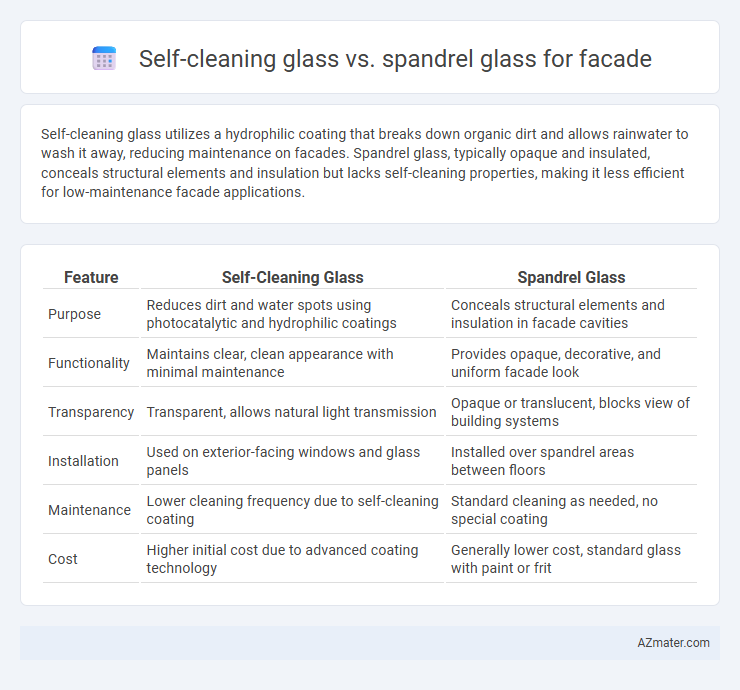Self-cleaning glass utilizes a hydrophilic coating that breaks down organic dirt and allows rainwater to wash it away, reducing maintenance on facades. Spandrel glass, typically opaque and insulated, conceals structural elements and insulation but lacks self-cleaning properties, making it less efficient for low-maintenance facade applications.
Table of Comparison
| Feature | Self-Cleaning Glass | Spandrel Glass |
|---|---|---|
| Purpose | Reduces dirt and water spots using photocatalytic and hydrophilic coatings | Conceals structural elements and insulation in facade cavities |
| Functionality | Maintains clear, clean appearance with minimal maintenance | Provides opaque, decorative, and uniform facade look |
| Transparency | Transparent, allows natural light transmission | Opaque or translucent, blocks view of building systems |
| Installation | Used on exterior-facing windows and glass panels | Installed over spandrel areas between floors |
| Maintenance | Lower cleaning frequency due to self-cleaning coating | Standard cleaning as needed, no special coating |
| Cost | Higher initial cost due to advanced coating technology | Generally lower cost, standard glass with paint or frit |
Introduction to Facade Glass Technologies
Facade glass technologies enhance building aesthetics and performance, with self-cleaning glass using a photocatalytic coating to break down organic dirt and hydrophilic properties for easy rainwater removal, reducing maintenance. Spandrel glass conceals structural elements and insulation behind the curtain wall, offering visual uniformity and energy efficiency without transparency. Selecting between these technologies depends on desired building maintenance, appearance, and thermal performance requirements.
What is Self-Cleaning Glass?
Self-cleaning glass features a hydrophilic surface coating that uses sunlight and rainwater to break down and wash away dirt, reducing maintenance for building facades. It integrates titanium dioxide nanoparticles that activate under UV light to decompose organic materials and dirt particles on the glass. In contrast, spandrel glass primarily serves aesthetic and insulation purposes by covering structural elements without transparency or self-cleaning capabilities.
What is Spandrel Glass?
Spandrel glass is an opaque or translucent panel used in building facades to conceal structural elements, insulation, or mechanical components behind the exterior glass curtain wall. Unlike self-cleaning glass, which has a special coating to reduce maintenance by breaking down organic dirt and allowing rainwater to wash it away, spandrel glass prioritizes aesthetic uniformity and energy efficiency rather than transparency or self-cleaning properties. It is commonly fabricated by adding ceramic frits, paints, or back coatings to control light reflectance and thermal performance while complementing the vision glass panels in the building envelope.
Key Functional Differences
Self-cleaning glass employs a hydrophilic coating that breaks down organic dirt with sunlight and allows rainwater to wash it away, significantly reducing maintenance efforts. Spandrel glass is opaque and designed to conceal structural elements, insulation, or mechanical systems behind the facade, providing aesthetic uniformity without transparency. While self-cleaning glass enhances visibility and cleanliness on transparent surfaces, spandrel glass prioritizes concealment and architectural integration in non-vision areas.
Aesthetic and Design Considerations
Self-cleaning glass enhances facade aesthetics by maintaining clarity and brightness through its photocatalytic and hydrophilic coatings, reducing maintenance and preserving the building's sleek, modern appearance. Spandrel glass offers design flexibility by concealing structural elements, insulation, or mechanical systems, and can be customized in various opaque colors, textures, and finishes to complement the overall facade design. Combining both glass types allows architects to achieve a harmonious balance between functional cleanliness and aesthetic uniformity in contemporary facade solutions.
Maintenance and Durability Comparison
Self-cleaning glass utilizes a photocatalytic coating that breaks down organic dirt and a hydrophilic surface that allows rainwater to wash away debris, significantly reducing maintenance frequency and costs compared to spandrel glass. Spandrel glass, often coated or painted to conceal building elements, lacks self-cleaning properties and typically requires more regular manual cleaning to maintain appearance. In terms of durability, both types offer strong resistance to weathering, but self-cleaning glass coatings may degrade over time and require reapplication, while spandrel glass maintains consistent surface integrity without specialized treatments.
Energy Efficiency Impacts
Self-cleaning glass enhances energy efficiency by reducing the need for frequent maintenance, lowering water and chemical usage, and improving solar heat gain through its hydrophilic or photocatalytic coatings. Spandrel glass, often opaque or insulated, contributes to energy savings by concealing structural components and enhancing thermal insulation, minimizing heat transfer and improving facade airtightness. Both glass types optimize facade performance, with self-cleaning glass focusing on maintenance-driven energy reduction and spandrel glass prioritizing thermal efficiency and building envelope integrity.
Cost Analysis: Self-Cleaning Glass vs Spandrel Glass
Self-cleaning glass typically costs 20-30% more than standard spandrel glass due to its specialized coating technology that reduces maintenance expenses over time. While spandrel glass offers lower upfront costs, it may incur higher long-term cleaning and replacement costs, especially on high-rise facades. Cost analysis favors self-cleaning glass for projects prioritizing lifecycle savings and reduced operational maintenance budgets.
Application Suitability in Modern Facades
Self-cleaning glass is ideal for facades in high-rise buildings and structures with extensive glass surfaces where maintenance access is challenging, offering reduced cleaning frequency through photocatalytic and hydrophilic coatings. Spandrel glass is primarily suitable for concealing opaque facade elements like columns, insulation, and mechanical components, providing a uniform exterior appearance without transparency. Both materials enhance facade aesthetics, but self-cleaning glass emphasizes functional maintenance benefits, while spandrel glass focuses on masking structural components in modern architectural designs.
Which Facade Glass Is Best for Your Project?
Self-cleaning glass reduces maintenance costs and keeps facades clear by leveraging photocatalytic and hydrophilic coatings that break down dirt and allow rainwater to wash it away, ideal for high-rise buildings exposed to pollution. Spandrel glass, typically opaque and used to conceal structural elements or insulation, enhances aesthetic consistency while protecting the facade's functional layers. Choosing the best facade glass depends on project priorities: prioritize self-cleaning glass for durability and low upkeep or select spandrel glass for design uniformity and structural integration.

Infographic: Self-cleaning glass vs Spandrel glass for Facade
 azmater.com
azmater.com